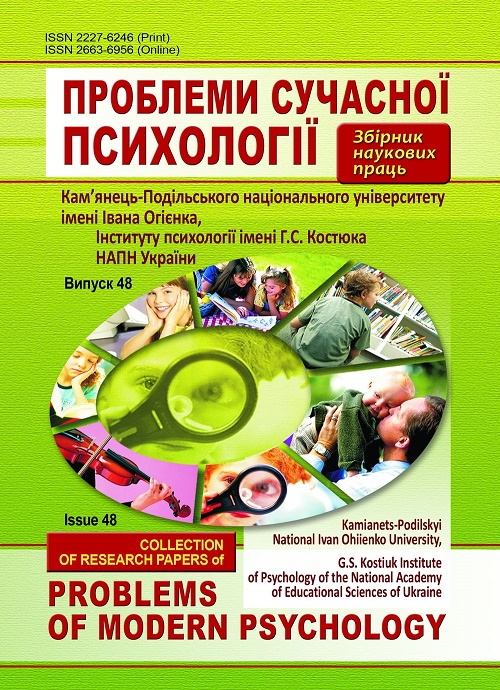Psychological Characteristics of Explication of Narration and Time in Graphic Novels
DOI:
https://doi.org/10.32626/2227-6246.2020-48.133-153Keywords:
narrative discourse, visual emphasis, focalization of information, epigraphs’ emphasis, meta-narrative presentation of the text, contrasting visual linkings, actualization of narrative potential.Abstract
The purpose of our article is to describe various narrative devices of the comic
book which can also enable the reader to identify to the characters in a new
way by concretely positioning the reader inside the point of view of a certain
character, and, on its basis to propose psycholinguistic aspects of narrative
discourse.
Methods of the research. The following theoretical methods of the research
were used to solve the tasks formulated in the article: a categorical method,
structural and functional methods, the methods of the analysis, systematization,
modeling, generalization.
The results of the research. It was underlined that the important part of
comic book narration was also the point of view: who was watching and what
was the object of this gaze; if a character was following something and in the
next panel we were shown this object of the gaze, the reader would be positioned
as this character. This type of positioning is essential in comic book narration, as
it has the possibility of affecting the meanings linked with the reading of the
comics.
It was described the role of visual images, which helped the reader to
understand the textual information. Through repetition the visual images
become symbols, which mean that they begin to represent something else
through a rule or a shared agreement. These symbols become narrative, and
act as parts of the narrative by the way of integrating the symbolic meanings
linked to them to new contexts. The symbols can even turn into metaphors, as for
example the recurring image of the Comedian being flung through the window,
which may be interpreted as speaking of the violence hidden in all of us.
It was shown that the type of transformation of visual information was
familiar from film studies, and it was a clearly visual way of narrating the past
private experiences of the character through external focalization, showing what
the character had experienced in the past but from outside the character. Still,
while reading the novel it is easy to notice how the use of visual elements to
provide smooth transitional moments in space and time is a practical advantage
of a rich visual style that exceeds the content of the words. This playing with
temporal levels and transitional moments in time and space is in fact an essential
quality of the narrative of «Watchmen», leading to the interpretation that
alongside power, time is one of the crucial overall themes of the graphic novel.
Conclusions. Analyzing «Watchmen», the author of this article proposed
such psycholinguistic aspects of narrative discourse, as: visual emphasis;
focalization of information; epigraphs’ emphasis; meta-narrative presentation
of the text; contrasting visual linkings; actualization of narrative potential.
It was shown that the panel arrangement can deceive the reader, too.
Various types of temporal situations that bear on our judgments of causality
may be created through the juxtaposition of spatial fragments from different
shots. In several storylines within «Watchmen», two parallel narratives are
presented to the reader in juxtaposition, happening simultaneously, so that a
parallel is drawn between them like in many other instances in the comic.
References
Chatman, S. (1978). Story and Discourse. Narrative Structure in Fiction and Film. New York : Cornell University Press. 98 p.
Genette, G. (1980). Narrative Discourse. An Essay in Method. Trans. New York : Cornell University Press. 136 p.
McCloud, S. (1993). Understanding Comics. The Invisible Art. New York : HarperCollins. 220 p.
Moore, A., & Gibbons, D. (1987). Watchmen. London : Titan Books (DC Comics). 108 p.
Mykhalchuk, N. O., & Ivashkevych, E. E. (2016). Psycholinguistic char-acteristics of visual narrative discourse. Психологія: реальність і перспективи: зб. наук. пр. Рівне : РДГУ. Вип. 7. С. 146–149.
Honcharuk, N., & Onufriieva, L. (2018). Communicative needs in the structure of the intercourse process. Fundamental and Applied Re¬searches in Practice of Leading Scientific Schools, 27 (3), 111–116. URL : https://farplss.org/index.php/journal/article/view/373.
Downloads
Published
How to Cite
Issue
Section
License
Copyright
The Editorial Board has the full right to publish original scientific papers containing results of theoretical and experimental research works which are not currently subject to review for publication in other scientific editions. The Author shall transfer to the editorial board of the Collection the right to spread the electronic version of the paper, as well as the electronic version of the paper translated into English (for papers originally submitted in Ukrainian and Russian) by all kinds of electronic means (placement at the official website of the Collection, electronic databases, repositories etc).
The Author of an article reserves the right to use materials of the paper, without approval with the editorial board and the founders of this Collection: a) partially or fully, for educational purposes; b) for writing own dissertation papers; c) for preparation of abstracts, conference reports and presentations.
The Author of an article can place electronic copies of the paper (including the final electronic version downloaded from the official website of the Collection) at:
- personal web resources of all Authors (websites, webpages, blogs etc.);
- web resources of the institutions where the Authors are employed (including electronic institutional repositories);
- non-profit public access web resources (for example, arXiv.org).
But in all cases, it is obligatory to have a bibliographic reference to the paper, or a hyperlink to its electronic copy placed at the official website of this Collection.






